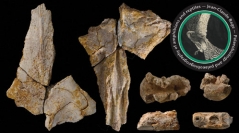

 Comptes Rendus Palevol
20 (20) - Pages 351-372
Comptes Rendus Palevol
20 (20) - Pages 351-372Briefly mentioned in 1915 by the palaeontologist Répelin, the mosasaurid Liodon asiaticum Répelin, 1915 was found by a missionary to Africa, a Father Ruffier, in Late Cretaceous strata near Jerusalem (without further details on the exact provenance). This material was never described in detail, figured, or revised and was recently rediscovered in the collections of the Muséum d’histoire naturelle of Marseille (Provence, southern France). Here we describe and figure for the first time this material, which now includes more specimens than the original lot mentioned by Répelin, and we propose new systematic assignments for the identified specimens. First of all we demonstrate that the five original vertebrae briefly described by Répelin representing a composite assemblage and being are not diagnostic at the specific level,. Thus Liodon asiaticum should be considered a nomem dubium. The most complete and diagnostic specimen belongs to a Mosasaurini (Mosasaurinae) incertae sedis, close to Mosasaurus Conybeare, 1822 and Plotosaurus Camp, 1951, as shown by in the unique configuration of its frontal-parietal-postorbitofrontal complex. The two other specimens are referred to identified as indeterminate Mosasaurinae. The study of several groups of microfossils (calcareous nannofossils, planktonic foraminifera and palynomorphs) found in the white chalk preserved with most of the bones constrains the age of these mosasaurid remains to the lower part of the middle Campanian (C. plummerae (Gandolfi, 1955) / G. rosetta (Carsey, 1926) and CC18 / UC14-15a Zones). This corresponds to the local Mishash Formation that crops out extensively East of Jerusalem (Mount of Olives and surroundings). Father Ruffier probably collected these bones in one of the outcrops of this formation, possibly not very far from where he worked and lived (Saint-Anne Community in Jerusalem). These chalky levels, common in the Middle East, represent a shallow and rather open marine environment, possibly near-shore.
Upper Cretaceous, Israel, Mosasauridae squamate, calcareous nannofossils, planktonic foraminifera, palynomorphs